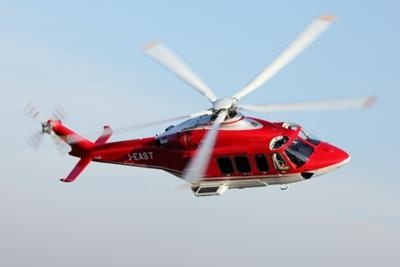AgustaWestland, ENAV, Have Finished First Stage Of Qualifications Flying An AW139
The first stage of qualification and authorization tests for the creation of the first helicopter Localizer Performance with Vertical guidance (LPV) Instrument Flight Rules (IFR) approaches, designed and developed in Milan Linate and Orio al Serio Airports, has been completed by ENAV and AgustaWestland flying an AW139 helicopter. The testing wrapped up June 10th.

The LPV approaches are based on the Global Navigation Satellite System (GNSS), augmented by the Satellite Based Augmentation System (SBAS), that will enable pilots to operate with ILS-like approach minima even where the ILS ground infrastructure is not available. This will allow more flights to land in lower visibility and low overcast conditions with high levels of safety. These two procedures are linked to a Performance Based Navigation (PBN) Low Level IFR route (KY139), already published and in service. These constitute the most advanced IFR network developed for rotorcraft using the PBN concept.
The trials were performed using an AW139 medium twin engine helicopter specifically equipped to monitor and process the data generated by ground and satellite based navigation systems. In particular, the reliability of navigation data and the navigation capabilities of the AW139, the latest generation helicopter in its class, were evaluated during the tests, while taking into account the expected evolution of satellite navigation systems. The AW139 has a state-of-the-art navigation suite (redundancy systems and multi-sensors on board), based on a dual Flight Management System (FMS) coupled with an advanced digital Automatic Flight Control System 4-axis autopilot that provides lateral and vertical guidance. These characteristics enable the helicopter to perform any LPV procedure in a fully automatic manner, especially even with extremely steep approach angles.
Avionic capabilities and on board technology combined with design criteria for rotorcraft instrument approach procedures are key factors when developing rotorcraft IFR capabilities and will be a valuable enhancement to rotorcraft operations, granting a high level of operational flexibility and flight safety
Utilizing air traffic services provided by ENAV (Ente Nazionale Assistenza al Volo – Italian Company for Air Navigation Services), units constantly tracked the aircraft while evaluating the flight accuracy. These flight trials represent an important milestone for the whole European aviation industry and helicopter community. LPV approaches are widely implemented in the U.S., and many will soon be deployed in Europe. These first IFR approach procedures, based on GNSS capabilities augmented by SBAS (EGNOS in Europe, WAAS in the U.S.) will support not only airport operations, but in the near future also access to remote locations where installation of conventional guidance systems are not possible.
The LPV procedures represent an improvement for rotorcraft operations on several levels:
- LPV procedures do not require local ground installations and can be deployed at minimum cost and with no maintenance costs at almost any location.
- LPV procedures provide precise and geometric vertical guidance which improve not only the safety, but also the comfort of flight.
- LPV helicopter dedicated approach procedures, reduce air controller workload, improve access to airports whilst reducing flight time, noise pollution and fuel consumption.
The activity, planned by ENAV with AgustaWestland involvement, is part of PROMETEO, (European Program-ACCEPTA) - “Pre-operational implementation assessments of EGNOS based procedures for aircraft and helicopters operations in Northern Italy” is to contribute to accelerate EGNOS adoption in the aviation sector in Italy, addressing the use of EGNOS both for aircraft and helicopters operations.
Rotorcraft have the potential to increase passenger throughput at medium and large airports. Airport/heliport accessibility and rotorcraft integration without interfering with fixed-wing aircraft traffic is seen as a major element to be taken into consideration for the successful implementation of rotorcraft operations, especially at a congested airport such as Milan Linate, which has more than 3500 helicopter movements per year.
Under this innovative and forward looking program AgustaWestland is committed to helping expand the safe and efficient use of rotorcraft platforms for passenger transport purposes in Italy, and giving an export model to the rest of the world.
(AW139 image provided by AgustaWestland)
 NTSB Prelim: Cirrus Design Corp SR20
NTSB Prelim: Cirrus Design Corp SR20 ANN's Daily Aero-Linx (11.30.25)
ANN's Daily Aero-Linx (11.30.25) ANN's Daily Aero-Term (11.30.25): Wind Shear Escape
ANN's Daily Aero-Term (11.30.25): Wind Shear Escape Aero-News: Quote of the Day (11.30.25)
Aero-News: Quote of the Day (11.30.25) Airborne 11.26.25: Bonanza-Baron Fini, Archer v LA NIMBYs, Gogo Loses$$$
Airborne 11.26.25: Bonanza-Baron Fini, Archer v LA NIMBYs, Gogo Loses$$$



